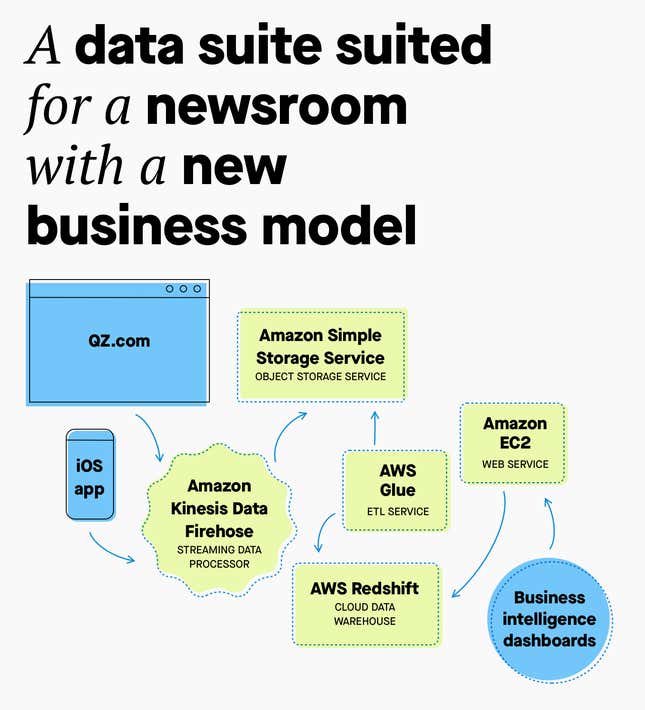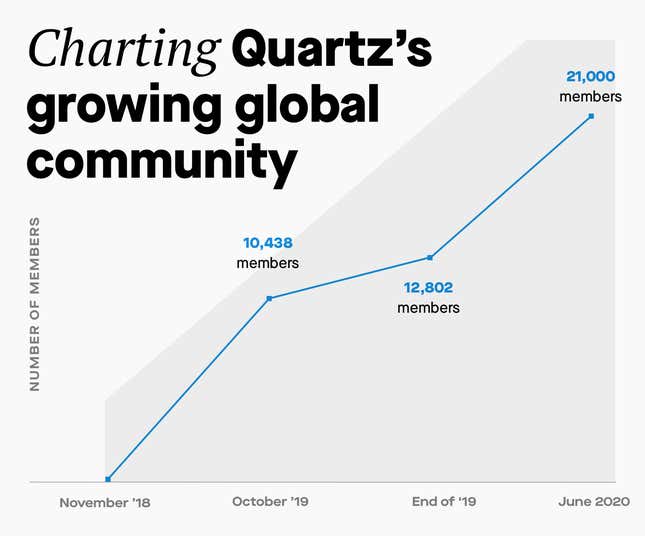Eight years ago, Quartz was born online. Its goals were three-fold: Keep a pulse on the global economy in fresh formats, cater to a new generation of business leaders, and ensure those leaders could get their news and analysis where they needed it most—on their mobile phones.
Launching as a 100 percent digital idea, it didn’t have to disentangle legacy systems or graft new technologies onto old business models. Being digitally native also meant that data—from the very first user ping on qz.com in 2012—could be used in real time to ensure those goals were being met.
Yet, after six years of robust growth in its global readers, advertisers, and coverage, Quartz needed to evolve its technology, specifically its data foundation, to stay truly competitive.
The catalyst for getting smarter about its stats came in 2018 when Uzabase, a Tokyo-based data, media, and consulting firm, acquired Quartz. Quartz’s new owner immediately initiated an operational, financial, and creative pivot. The mandate? Replicate the success of its NewsPicks USA arm, a Uzabase app that ran on a hybrid of advertising and membership revenue.
Fueling a startup with speed and ease
This strategy shift aimed to turn loyal readers into committed, paying subscribers and to diversify the company’s revenue stream. At the time, Quartzians throughout the newsroom and product division knew how to deliver data-driven intel about the ideas and companies powering the globe. Now they needed to gain and use deeper insights from the vast amounts of information their own business generated.
A new subscription service could only work if reader data could be collected, analyzed, and leveraged for decision-making across all the teams responsible for the business line’s growth—editorial, product, and marketing. Not to mention, this data had to be available in a quick, user-friendly, and standardized way.
So Quartz looked to AWS to be its anchor and its engine.
1. Flexible frameworks
One of the organization’s first missions following the Uzabase acquisition was reinventing the parent company’s NewsPicks USA app as the new Quartz app. For speed to launch, the product and engineering team would reuse as much of the layout and functionality of the inherited app as possible, but the in-house data team hit an almost immediate snag: reader information that was isolated, massive, and inconsistently organized.
“The reader data drawn from the Quartz website and the NewsPicks USA app sat in two different silos, and that made certain types of analysis impossible,” remembers Chris Saunders, Quartz director of analytics.
Plus, each of those single datasets was large, Saunders says, including 20-22 million unique users to qz.com every month, with 250-300 million events off those users. This meant that they had a gold mine that could answer questions critical to getting membership up and running if only they could coalesce it. That data could reveal which articles those users read, which ones they finished, where they navigated to next on qz.com, and if they were reading on their phones or on their laptops.
Both NewsPicks USA and qz.com were supported by AWS at the time; however, the two products had approached their data infrastructure in very different ways and were at different stages of integration. But navigating this data fusion against a tough deadline was possible because both companies had those solid frameworks on AWS already. “The merger meant we didn’t have to build our own infrastructure or chance losing all that valuable user data in the process,” Saunders said.
Within months, the data merge was complete.
2. Secure storage
The second step was to store this combined data in a way that was both safe and operative by different parts of the business. “Up until 2018, we had a number of different categories—first-party user data, billing and subscription management, and site and app engagement data—with no way to look at it in the aggregate,” says Lexie Ernst, Quartz product manager. This solved the short-term data needs unique to either the newsroom or to the advertising team rather than the data being used as a valuable resource shared across the company.
Now its trove is consolidated and protected by a three-part AWS system: a data lake built on Amazon Simple Storage Service (Amazon S3), Amazon Relational Database Service (Amazon RDS) for safeguarding its metadata, which is info about the data, and Amazon Redshift, its data warehouse for analytics.

What that translates to day-to-day is that the company can comb through dimensional information (reader email addresses, job titles) plus transactional metrics (page views, clicks) to get a macro view of its fanbase.
This restructuring is most visible in Quartz’s recent experiments around the paywall, a technical way to limit readers’ entry to content to encourage subscribing. Despite solid site traffic, readers who hit the paywall and went to purchase a membership to keep reading original Quartz articles didn’t always complete the signup process, and there was no way to find out why they changed their mind or coax them into the fold. So in the summer of 2020, the Quartz product team reengineered the process to first collect a user’s email address before moving onto the payment screen.
Those who dipped out then received targeted emails crafted by the marketing team, which have a high conversion rate to paying membership.
This small tweak has already had a big impact. “We were able to grow our marketing lists by thousands of leads each month, 2% of which converted to membership within 60 days of giving us their email address,” states Ernst.
3. Automated intel
The metrics are stored in Amazon S3 in a raw, unstructured format. “For every piece of data you capture and contain, you then have to move and transform it for the information to be truly useful,” Saunders explains.
To organize and retrieve this information, AWS Glue performs ETL (extract, transform, load) services into S3 or Redshift to craft a metadata catalog. Then Redshift connects with Glue to access data in its queries.
“Imagine giving your lunch order to a waiter who gives it to the kitchen: ‘I want a Caesar salad with grilled chicken, extra dressing, and no anchovies.’ You specify the end state, and Redshift returns the answer,” describes Saunders.
Redshift is a cloud data warehouse that helps the team easily combine all this data. For example, it’s easy to gain insights from “hot data you’re querying more often, but smaller in scale,” Saunders says. For example, an editor might need six months of page-view information. The Redshift Spectrum feature also enables quick access to “cold data” saved in the data lake at a much larger scale, such as page-view metrics since 2012.
The combination of Amazon S3, AWS Glue, and Amazon Redshift powers deeper cross-sectional analysis, such as layering user profile data on story data to get a better understanding of what content college students gravitate to and which stories are must-reads by corporate executives.
Additionally, Redshift queries power all of the business intelligence dashboards at Quartz, which can be easily set up to follow certain metrics automatically. For instance, one dashboard visualizes new users and where they came from, whether a link from one of Quartz’ popular newsletters, via a Google search, or directed to the site from a trending tweet.
Combined, these dashboards allow the marketing and product teams to get a bird’s-eye view of the myriad user journeys toward conversion. But they also empower the newsroom to see how their articles are collectively contributing to membership, not just the news stories that compel users to get out their credit cards.
At one point, Quartz witnessed its career-related stories had the power to turn casual visitors into new members; the data showed that readers want information they can immediately put into practice. So now the membership team frequently includes a management training article in its exclusive story packages called field guides. “You can retain users with data, not just acquire them,” Ernst attests.
The data also revealed February’s VC Boom field guide was the eighth best to date on converting paid members. So less than two months later, Quartz published the other side of the same idea: Why Startups Fail. That guide outperformed its predecessor by 20 percent and is now #6 on 2020’s list of powerful convertors.
4. Effortless integrations
Quartz does still use third-party vendors, but even here, AWS plays a role. Amazon Kinesis Data Firehose connects to other software to prepare and load real-time data streams into data stores and analytics services. These integrations include SendGrid for email data crucial to the newsroom, Stripe for reader payment information used by the marketing team, and GitHub, a critical staging environment tool for Quartz’ in-house engineers.
With Kinesis, “we can create a pipeline to capture the data, reformat it a little bit, and deliver it to the analytics team,” Saunders says. For example, SendGrid data, like email open rate and click-through rate, goes through the Amazon API (application programming interface), then it’s processed through the Kinesis stream. Next, Kinesis drops the data into S3 and into Amazon Redshift,” he says. Before Kinesis, the analytics team would have to log in to SendGrid separately in order to send over data.
With this flow, Saunders’ team can see the raw data to answer any question internal teams want as opposed to seeing the data in the constraints of how the vendor set up their user database.
Reorganizing data and the people who depend on it
In the end, AWS is critical for digital startups like Quartz to run analyses more efficiently and more broadly to support both the bottom line and the employees responsible for it.
“Business and editorial both want to serve our 22,000 and counting members, and both need data to do it well,” says Frick.

Since October 2019, this data-driven, all-hands-on-deck initiative has doubled the Quartz membership community and made the organization that much more knowledgeable about its audience makeup. For example, more than a third of Quartz members are in the C-suite, and more than half are based outside the US.
What’s more, continuous data streams help journalists better understand the value of their reporting. It’s this responsiveness to reader preferences that keeps them coming back for more, according to a 2020 member survey. In it, Quartz readers cited the quality of the content as the number one reason for their loyalty.
But just as importantly, AWS has affected how Quartz organized not only data but also itself.
Before AWS, analytics was just serving the needs of the advertising side. “With the analytics function moved under the company’s product umbrella and the data services moved to AWS, we can craft the exact analytics system with wider utility using the building blocks of AWS,” Saunders says. With just a two-person team, they can keep tabs on more reader actions across more reader touch points even as the turnaround time on analysis goes down.
In fact, any Quartz employee can drop questions in an analytics channel on Slack, which is pinged with dozens of requests each week. What topics do readers depend on? How did they first discover Quartz? What’s their preferred format to engage with Quartz: email, app, ads, e-commerce pages, virtual events?
“Having a collaborative relationship between analytics and different teams and having data that’s democratized and usable lets us innovate with even more ambition.”
